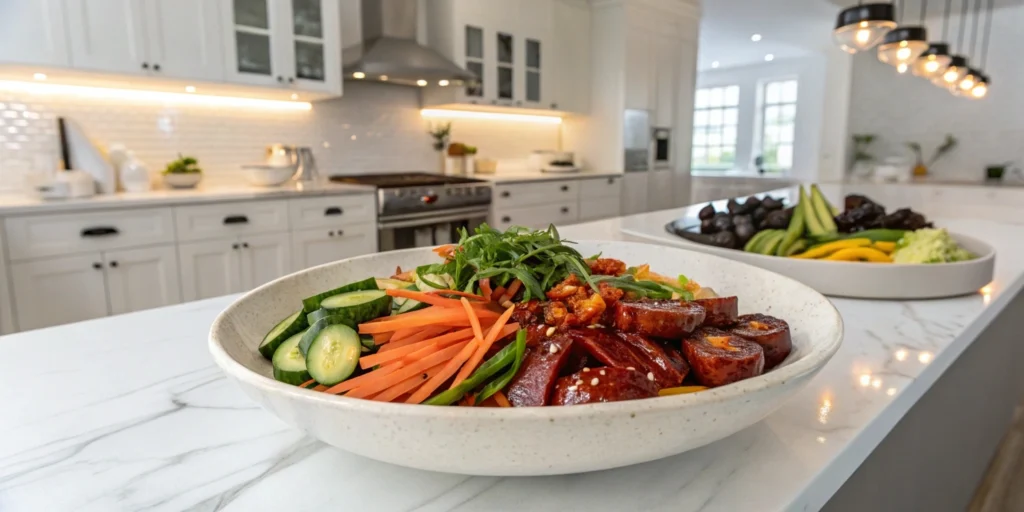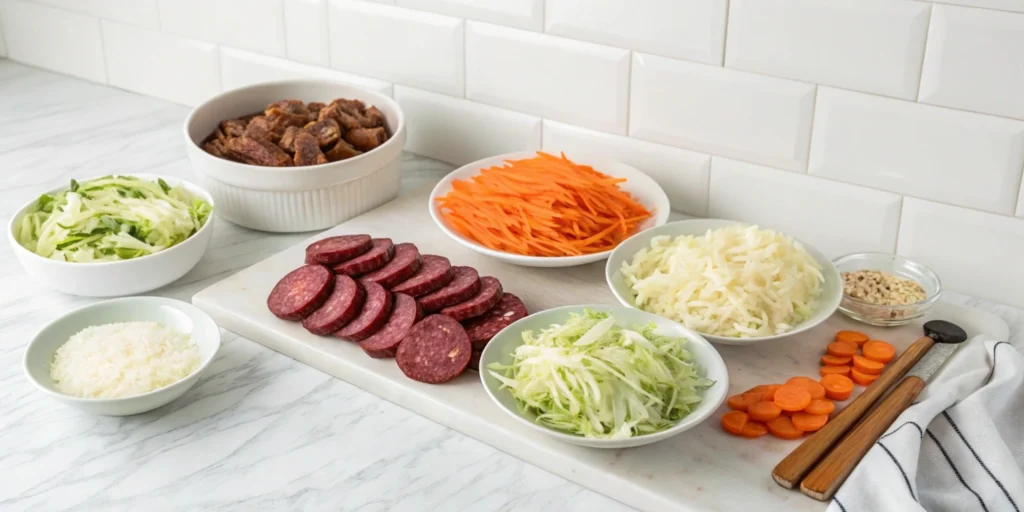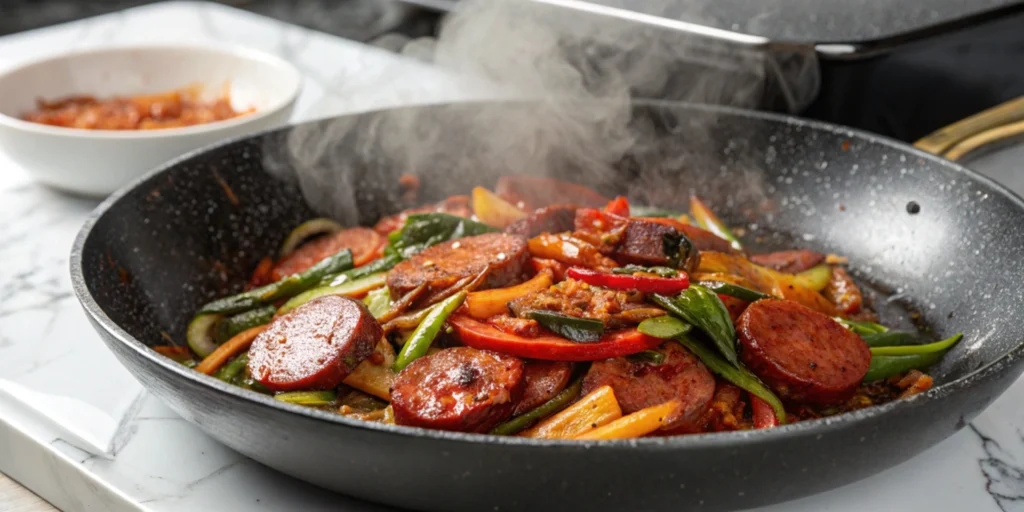
Table of Contents
Soondae Bokkeum (순대 볶음) is more than just a dish—it’s a vibrant tapestry of flavors and textures that embodies the heart of Korean street food culture. This stir-fry masterpiece features Korean blood sausage (soondae), fresh vegetables, and a bold, spicy sauce that packs a punch. With the right ingredients and techniques, you can recreate this delectable experience in your own kitchen. Let’s dive into the details and unlock the secrets to crafting an authentic Soondae Bokkeum that’s both comforting and irresistible.
What Is Soondae Bokkeum?
Soondae Bokkeum is a beloved Korean stir-fry dish featuring soondae, a type of blood sausage filled with a mix of pork blood, glass noodles, and various seasonings. These bite-sized pieces are stir-fried with an array of vegetables such as cabbage, onions, and carrots, all coated in a robust, spicy sauce made with gochujang (Korean red pepper paste) and gochugaru (Korean red pepper flakes). This dish is a popular choice at pojangmachas (street food stalls) and holds a special place in Korean comfort food culture.
The Five Bold Flavors of Soondae Bokkeum
1. The Smoky Depth of Gochujang
Gochujang is the soul of Soondae Bokkeum’s sauce. This fermented chili paste offers a deep, smoky heat balanced by a hint of sweetness. It creates the dish’s signature spicy flavor and helps bind all the ingredients together.
Tip: For a milder version, you can reduce the amount of gochujang and add a bit of honey to balance the heat.
2. The Umami Boost of Soy Sauce
Soy sauce adds a savory backbone to the dish, enhancing the natural flavors of the vegetables and soondae. The interplay between soy sauce and gochujang creates a harmonious balance of salty and spicy notes.
Tip: Opt for a high-quality soy sauce to elevate the overall taste.
3. The Heat Kick from Gochugaru
Gochugaru provides a vibrant color and a peppery kick. These Korean red pepper flakes are essential for achieving the perfect level of spiciness while complementing the smokiness of gochujang.
Tip: Adjust the quantity of gochugaru depending on your heat tolerance.
4. The Earthy Touch of Sesame Oil
A drizzle of sesame oil at the end of cooking adds a nutty aroma and a velvety finish. This earthy touch brings out the richness of the soondae and balances the bold spices.
Tip: Use toasted sesame oil for a deeper flavor.
5. The Freshness of Stir-Fried Vegetables
The crispness of cabbage, the sweetness of onions, and the crunch of carrots add a refreshing contrast to the chewy texture of soondae. Vegetables also provide a welcome burst of nutrients.
Tip: Don’t overcook the vegetables—they should retain a slight crunch to balance the dish’s textures.
Step-by-Step Guide to Replicate Soondae Bokkeum at Home

Ingredients:
- 700g of soondae (Korean blood sausage): Slice into bite-sized pieces.
- 2 handfuls of cabbage: Roughly chopped.
- 1 medium onion: Thinly sliced.
- 1/2 carrot: Julienne into thin strips.
- 2 handfuls of rice cakes (tteok): Soaked in warm water if hardened.
- 3 chili peppers: Thinly sliced for added heat.
- 2 tablespoons of sesame oil: To finish the dish.
- 1 green onion: Chopped for garnish.
For the Sauce:
- 2 tablespoons gochujang
- 2 tablespoons gochugaru
- 4 tablespoons soy sauce
- 2 tablespoons plum extract or honey
- 2 tablespoons oligosaccharide or corn syrup
- 1 tablespoon cooking wine
- 4 tablespoons water
Instructions:

- Prepare Your Ingredients: Slice the soondae, chop the vegetables, and soak the rice cakes in warm water if needed. This ensures all components cook evenly and blend seamlessly.
- Make the Sauce: In a small bowl, mix gochujang, gochugaru, soy sauce, plum extract, oligosaccharide, cooking wine, and water. Stir until smooth.
- Stir-Fry the Vegetables: Heat a large pan or wok over medium heat. Add a splash of oil and sauté the onion until it turns translucent. Toss in the cabbage and carrots, cooking until slightly softened.
- Incorporate the Sauce and Rice Cakes: Pour the prepared sauce over the vegetables and mix thoroughly. Add the soaked rice cakes and cook for 3-5 minutes, allowing them to absorb the flavors and soften.
- Add the Soondae: Gently place the sliced soondae into the pan. Stir carefully to avoid breaking the pieces. Cook for 2-3 minutes until the soondae is heated through.
- Finish with Sesame Oil: Drizzle sesame oil over the dish and toss gently. Garnish with chopped green onions and chili peppers.
- Serve Hot: Transfer to a large plate and enjoy immediately, paired with steamed rice or as a standalone dish.
Nutritional Insights of Soondae Bokkeum
Soondae Bokkeum is not just a treat for your taste buds—it’s packed with nutrients. Here’s what you’re getting:
- Protein and Iron: The soondae provides a good source of protein and iron, essential for muscle function and oxygen transport.
- Fiber and Vitamins: Vegetables like cabbage and carrots add fiber, vitamin C, and antioxidants to the dish.
- Mind the Sodium: While the sauce is flavorful, it can be high in sodium. Opt for low-sodium soy sauce to make it healthier.
- Moderation is Key: Due to the rich ingredients, enjoy Soondae Bokkeum in moderation as part of a balanced diet.
Tips to Perfect Your Soondae Bokkeum
- Avoid Overcooking Soondae: The sausage can become tough if overcooked. Add it towards the end and handle with care.
- Control the Spice: If you prefer a milder version, reduce the gochujang and gochugaru and add more sweetener.
- Use Fresh Ingredients: Fresh vegetables and high-quality soondae make a noticeable difference in flavor.
- Experiment with Add-Ins: Feel free to add mushrooms, bell peppers, or even seafood for a creative twist.
Frequently Asked Questions About Soondae Bokkeum
What does Soondae Bokkeum taste like?
Soondae Bokkeum offers a spicy, savory, and slightly sweet flavor profile, complemented by the chewy texture of soondae and the crunch of stir-fried vegetables.
Can I make Soondae Bokkeum vegetarian?
Absolutely! Substitute soondae with mushrooms or tofu for a plant-based alternative while keeping the bold flavors of the sauce.
Where can I find Soondae?
You can find soondae at Korean grocery stores or online specialty food retailers. Some stores also carry pre-sliced, ready-to-cook soondae for convenience.
How do I store leftovers?
Place leftovers in an airtight container and refrigerate for up to two days. Reheat gently in a pan to maintain texture and flavor.
Conclusion
Now that you know how to master Soondae Bokkeum, it’s time to bring the bold flavors of Korea into your kitchen. Share your creation with friends and family or enjoy it as a comforting solo meal. Don’t forget to tag your delicious creations on social media to inspire others to join in the culinary adventure. It’s your turn to enjoy the essence of Korean street food—one bite at a time!
